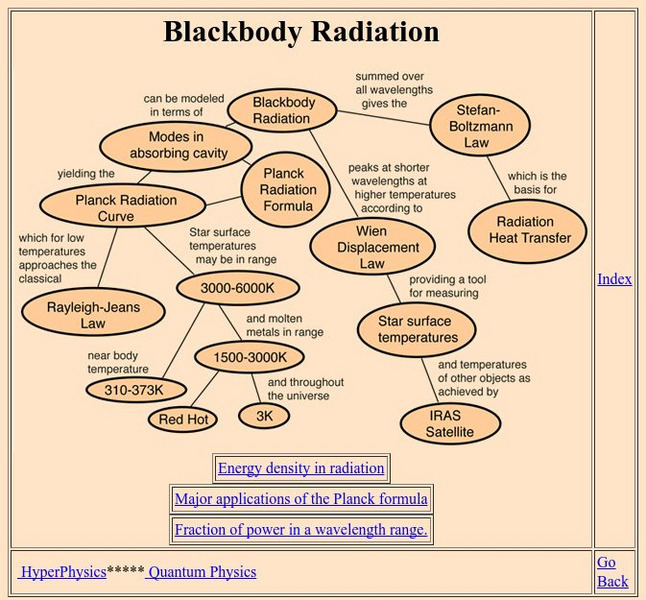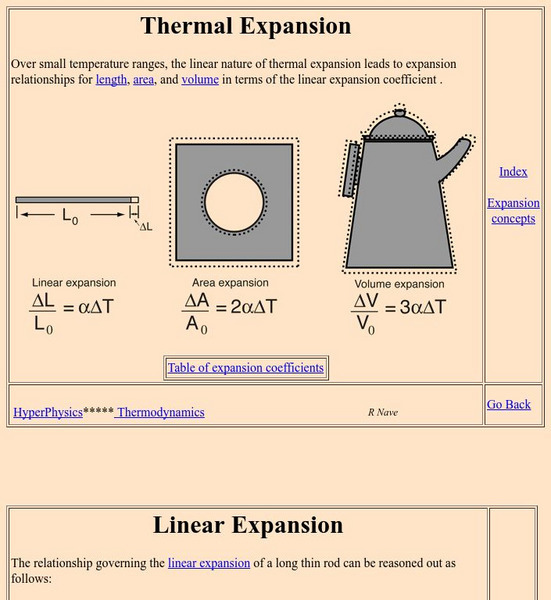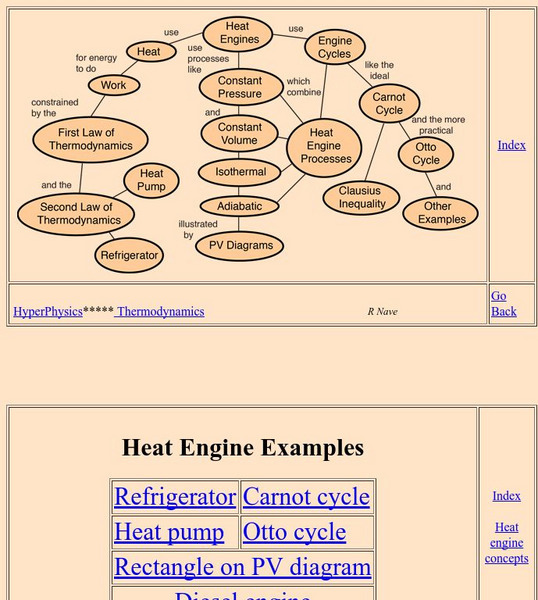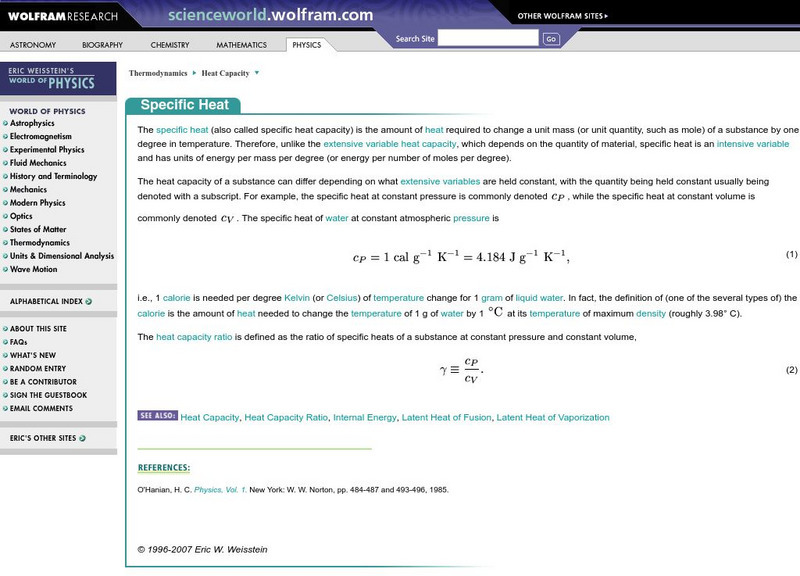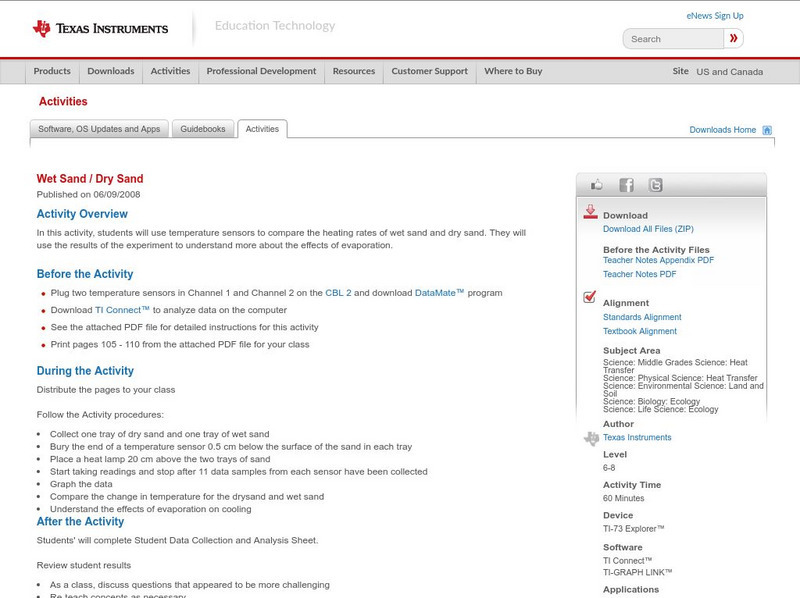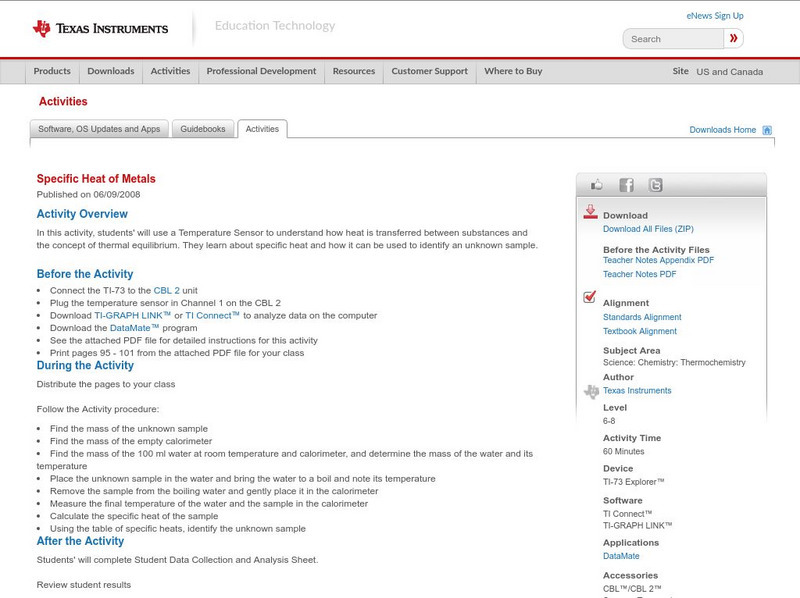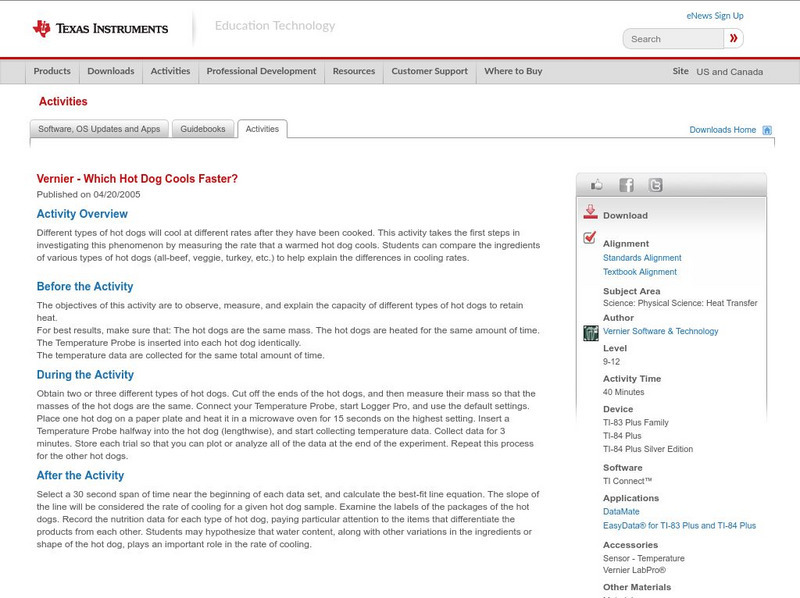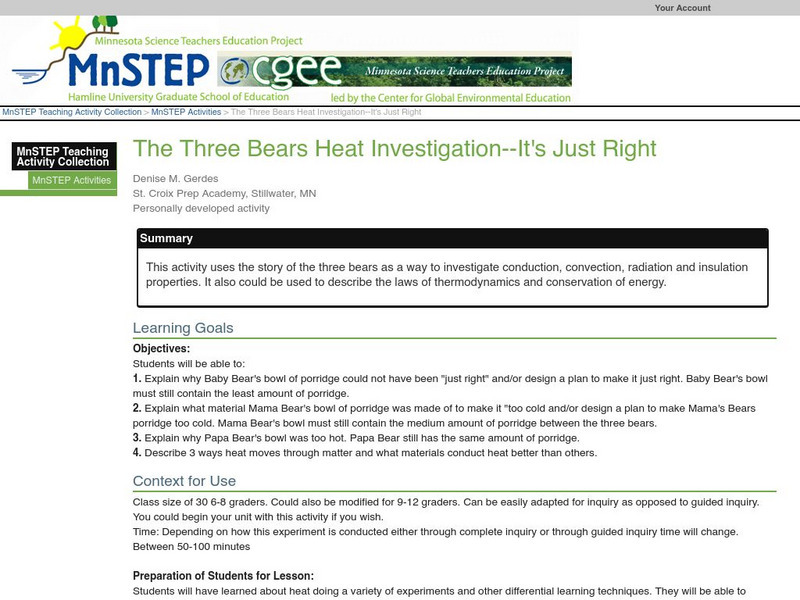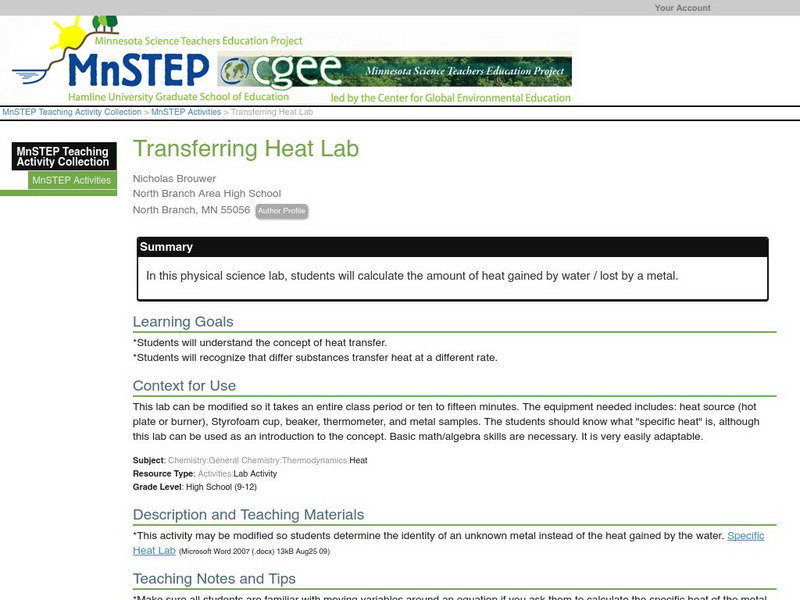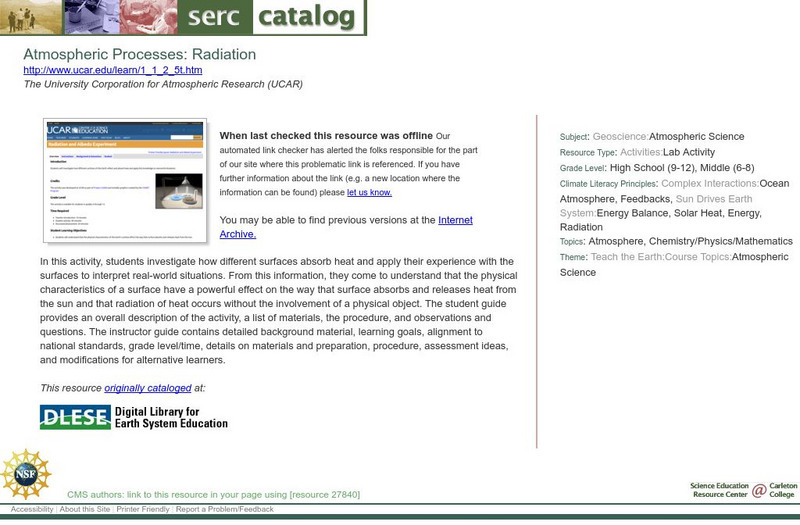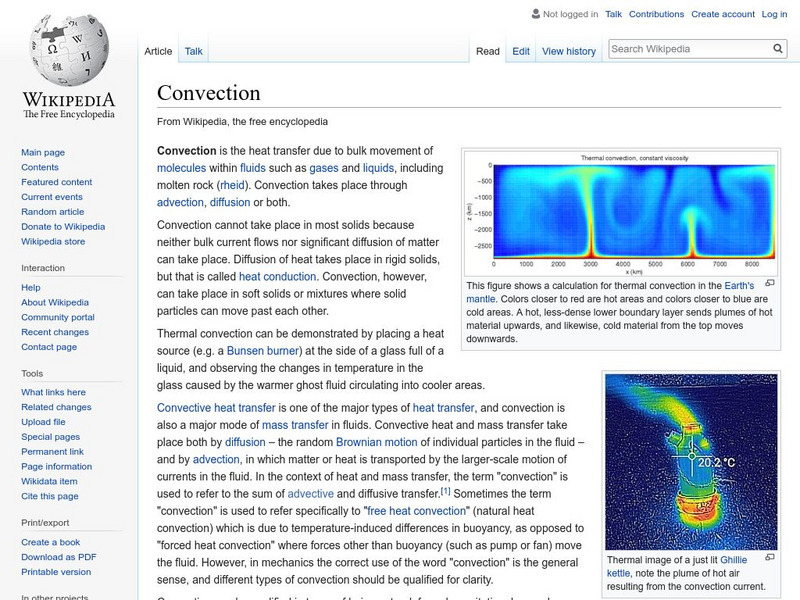Georgia State University
Georgia State University: Hyper Physics: Zeroth Law of Thermodynamics
The principle of thermal equilibrium is discussed and explained. The zeroth law of thermodynamics is stated. Links to several other pages with related information are provided.
Georgia State University
Georgia State University: Hyper Physics: Heat Engine Cycle
The heat engine cycle is defined and discussed. So pressure-volume diagrams are introduced and their use in depicting the cycles of a heat engine is demonstrated. Informative graphics are accompanied by reason-filled explanations.
Georgia State University
Georgia State University: Hyper Physics: Blackbody Radiation
An indexing page for the HyperPhysics site. This page includes a concept map of links to pages that contain information related to blackbody radiation. Each individual page consists of informative graphics and clear explanations.
Georgia State University
Georgia State University: Hyper Physics: Temperature
A page describing the concept of temperature and temperature scales. An interactive JavaScript form allows the visitor to investigate the relationship between the Kelvin, Celsius and Fahrenheit scales; enter a value and allow the...
Georgia State University
Georgia State University: Hyper Physics: Thermal Expansion
Defines thermal expansion and elaborates on the concept of linear expansion. Provides the equation for linear expansion and includes an interactive JavaScript form which allows the visitor to investigate the relationship between...
Georgia State University
Georgia State University: Hyper Physics: Expansion Concepts
An indexing page from Georgia State University Physics Department which includes links to various other pages with information pertaining to thermal expansion. From expansion coefficients to equations to calculation and practice pages,...
Georgia State University
Georgia State University: Hyper Physics: Area Expansion
The concept of area expansion is presented and explained. An equation for calculating the amount of area expansion is provided.
Georgia State University
Georgia State University: Hyper Physics: Bimetallic Strips
The operation of bimetallic strips is explained and illustrated. The principle of thermal expansion is related to their operation. A link to applications of bimetallic strips is provided.
Georgia State University
Georgia State University: Hyper Physics: Heat Engine Concepts
An indexing page for the HyperPhysics site. The page contains a concept map of links to a variety of other pages which discuss concepts related to heat engines. All pages contain informative graphics and excellent explanations.
Massachusetts Institute of Technology
Mit: Open Course Ware: Heat Transfer and Thermal Expansion
Students explore heat transfer and thermal expansion. Some topics examined in the activities are thermodynamic cycles, temperature scale, and bimetals. The resource consists of video clips, lecture notes, and exam questions with detailed...
Wolfram Research
Wolfram Science World: Specifiic Heat
This site has information on specific heat,the amount of heat required to change a unit mass of a substance by one degree in temperature. Included are many links and formulas.
Texas Instruments
Texas Instruments: Wet Sand / Dry Sand
In this activity, Students can use temperature sensors to compare the heating rates of wet sand and dry sand. They will use the results of the experiment to understand more about the effects of evaporation.
Texas Instruments
Texas Instruments: Specific Heat of Metals
In this activity, students' will use a Temperature Sensor to understand how heat is transferred between substances and the concept of thermal equilibrium. They learn about specific heat and how it can be used to identify an unknown sample.
Texas Instruments
Texas Instruments: Which Hot Dog Cools Faster?
Different types of hot dogs will cool at different rates after they have been cooked. This activity takes the first steps in investigating this phenomenon by measuring the rate that a warmed hot dog cools. Students can compare the...
Texas Instruments
Texas Instruments: Body Cooling Rate of Animals
Students make two models to stimulate the cooling rate of different skin surface areas. They use a Temperature Sensor to measure the cooling rate of the models. The students also compare the cooling rates of the models to determine the...
Texas Instruments
Texas Instruments: Heat Transfer by Conduction
The purpose of this activity is to monitor the transfer of heat between 2 materials by measuring the temperature changes in them.
Texas Instruments
Texas Instruments: Subnivean Comfort
Students measure and compare air temperatures inside and outside a snow shelter. If students choose to sleep in the shelter overnight they use the temperature measurements to confirm what they discover experientially- that snow is a...
Science Education Resource Center at Carleton College
Serc: The Three Bears Heat Investigation It's Just Right
This activity uses the story of the three bears as a way to investigate conduction, convection, radiation, and insulation properties. It also could be used to describe the laws of thermodynamics and conservation of energy.
Science Education Resource Center at Carleton College
Serc: Heat Transfer
Young scholars explore how different colors absorb or reflect heat using a black can of water, a white can of water, and a plain can of water.
Science Education Resource Center at Carleton College
Serc: Heat Transfer Heat Absorption
Learners will be given a chance to place their hands on two different objects and then predict on which an ice cube will melt more quickly. Students will make a prediction as to what will happen when balloons filled with air and with...
Science Education Resource Center at Carleton College
Serc: Transferring Heat Lab
In this physical science lab, young scholars calculate the amount of heat transfer between water and a metal.
Science Education Resource Center at Carleton College
Serc: Tracking Global Climate Change: Microfossil Record of Planetary Heat Pump
This lesson plan integrates physics, biology, and geology to understand planetary processes that contribute to climate change through time. It includes an activity that demonstrates heat transfer and it uses figures and charts to...
Science Education Resource Center at Carleton College
Serc: Atmospheric Processes: Radiation
In this activity, students investigate how different surfaces absorb heat and apply their experience with the surfaces to interpret real-world situations. From this information, they come to understand that the physical characteristics...
Wikimedia
Wikipedia: Convection
Wikipedia offers information on convection, the transfer of heat by the motion of or within a fluid. Includes table of contents, image, and formulas.




